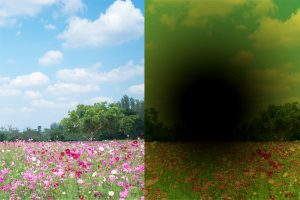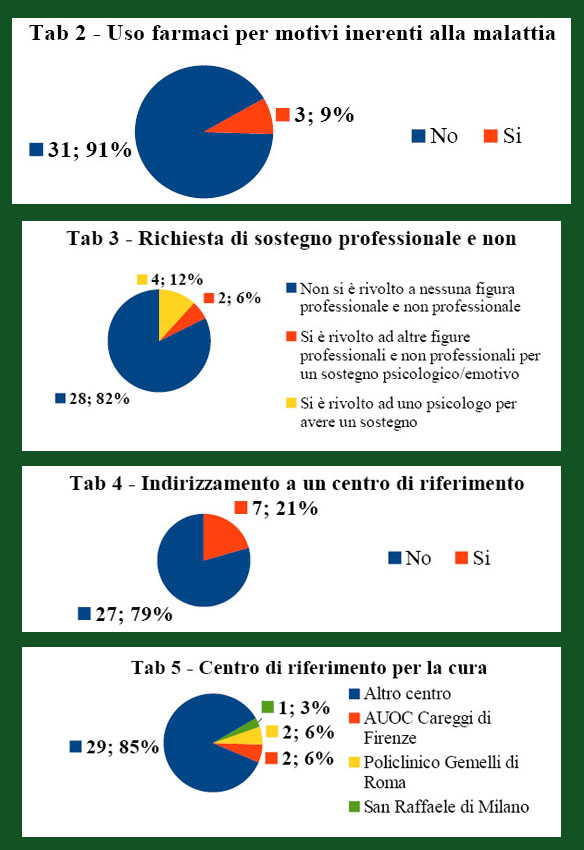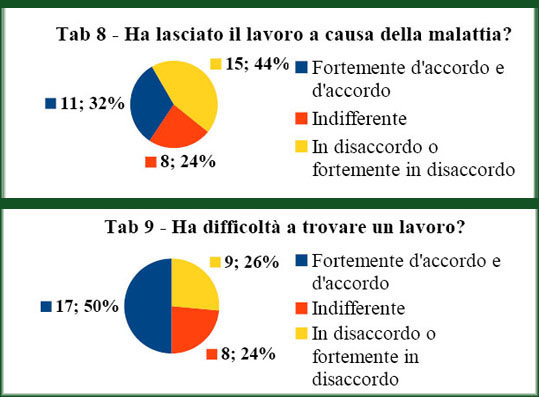Stargardt syndrome is a genetic disorder that leads to severe low vision in adolescents and adults. Clinically, it is relatively well known, but there is an apparent lack of interest in the psycho-social aspects of the disease; elements investigated in the present investigation.


Research
The research included the development of an ad hoc questionnaire disseminated through AISSt (Italian Stargardt Syndrome Association) and dedicated groups on major 'social network'.
Sources
The data obtained were stored in digital format and analysed with the programme EpiInfo 3.4 (released by "Center of Disease Control and Prevention'.).
Testimonials and participants
Subsequently, data were integrated from two interviews with privileged witnesses from which some key concepts were extrapolated.
We recruited 34 participants nationwide, 11 women and 23 men with range aged between 7 and 69 (average age 35) plus 2 respondents.
Stargardt Syndrome Research
The sentences below, highlighted in inverted commas, are the comments made by the participants.
"After diagnosis one feels left to one's own devices".
Almost half of the subjects claim to have had a diagnosis difficult to handle emotionally (Tab. 1), Of these, four had to turn to a psychologist (Tab. 3) and three resorted to drugs to control pathological emotional states that emerged after diagnosis (Tab. 2).
"... It would be helpful to be part of a specialised centre,(...) I only became aware of it through social networks.
The issue of access to services for those suffering from Stargardt's syndrome proves worrying; not only are the largest specialised centres in the country underused (Tab. 5), but there are often no indications of adequate facilities for taking care of these patients (Tab. 4).
Finding such centres independently by patients seems to be a real feat (Tab. 6). We can state that 9 times out of 10 operators give a diagnosis without indicating the appropriate centres for assistance, and since these centres prove to be difficult to find, the direct consequence is a lengthening of the time needed to access services.
"... After finishing secondary school the teacher advised me (...) to play the piano, sing, be a telephone operator or a masseur (...).
The school situation experienced by these people does not improve the overall picture.
The data from the interviews show that the educational institution is poor and discouraging: for those suffering from Stargardt syndrome, the difficulty of vision and reading are important. Appropriate tools are usually lacking and teachers are not prepared to handle the situation, often giving little hope.
From the data reported in Tab. 7 and from the comments above, we can deduce that this disease tends to isolate those affected by it both through objective difficulties (problems in driving, misunderstanding, situational difficulties...) and subjective difficulties (denial, fear of appearing fragile...) and in the visual field. These difficulties negatively affect social life, especially due to the embarrassment that the limitations induced by the disease create.
In order to investigate the employment sphere, we asked the participants whether they had had to give up their jobs (Tab. 8) and whether they had difficulty finding one (Tab. 9) because of their illness. It turned out that half of those who are ill, due to the progression of the illness, are not economically independent because they have difficulty finding a job, while 1 in 3 had to give up their job. These are therefore people who are forced to live dependent on their family or partner, with all the emotional implications that this entails. The Tab. 10 highlights the needs of the individual that emerged from the survey carried out and the responses implemented by the National Health System.
Research conclusions
I economic supports and emotional should be implemented to ensure effective help. In particular, it would be helpful:
- Improving the accessibility of specialised centres; - Recognising psychological, economic and legal support for sufferers and providing appropriate treatment; - Facilitating interaction and meetings between people with Stargardt syndrome; - Providing specific tools for schools to minimise the difficulties of those with visual impairment.
Researcher: Vincenzo Di Maio
E-mail: vincenzo_uni@yahoo.it
Speaker: Giampiero Montanelli
E-mail: g.montanelli@usl11.toscana.it
Co-rapporteur: Dr Calamassi Diletta E-mail: diletta.calamassi@mail.com
The issue of access to services for those suffering from Stargardt's syndrome proves worrying; not only are the largest specialised centres in the country underused (Tab. 5), but there are often no indications of adequate facilities for taking care of these patients (Tab. 4).
Finding such centres independently by patients seems to be a real feat (Tab. 6). We can state that 9 times out of 10 operators give a diagnosis without indicating the appropriate centres for assistance, and since these centres prove to be difficult to find, the direct consequence is a lengthening of the time needed to access services.
"... After finishing secondary school the teacher advised me (...) to play the piano, sing, be a telephone operator or a masseur (...).
The school situation experienced by these people does not improve the overall picture. Data from the interviews show that the educational institution is poor and discouraging: for Stargardt syndrome sufferers the reading difficulties are important. Appropriate tools are usually lacking and teachers are not prepared to handle the situation, often giving little hope.
From the data reported in Tab. 7 and from the comments above, we can deduce that this illness tends to isolate those affected by it due to both objective difficulties (problems in driving, misunderstanding, situational difficulties...) and subjective difficulties (denial, fear of appearing fragile...). These difficulties negatively affect social life, especially because of the embarrassment that the limitations induced by the disease create.
In order to investigate the employment sphere, we asked the participants whether they had had to leave their jobs (Tab. 8) and whether they had difficulty finding one (Tab. 9) because of their illness. It turned out that half of those who are ill are not economically independent because they have difficulty finding a job, while 1 in 3 had to leave their job. These are therefore people who are forced to live dependent on their family or partner, with all the emotional implications that this entails. The Tab. 10 highlights the needs of the individual that emerged from the survey carried out and the responses implemented by the National Health System.
Research conclusions
I economic supports and emotional should be implemented to ensure effective help. In particular, it would be helpful:
- Improving the accessibility of specialised centres;
- Recognising psychological, economic and legal support for sufferers;
- Facilitating interaction and meetings between people with Stargardt syndrome;
- Provide schools with specific tools to minimise difficulties for those with visual impairments.
Researcher: Vincenzo Di Maio
E-mail: vincenzo_uni@yahoo.it
Speaker: Giampiero Montanelli
E-mail: g.montanelli@usl11.toscana.it
Co-rapporteur: Dr Calamassi Diletta
E-mail: diletta.calamassi@mail.com
1) Robert S. Molday, Kang Zhang, 13 June 2010, 'Defective lipid transport and biosynthesis in recessive and dominant Stargardt macular degeneration', http://www.sciencedirect.com/science/article/pii/S0163782710000330, NIH (Nationa Institute of Health).
2) August F. Deutman, January 2003, 'Stargardt disease', http//:www.orphe.net/data/patho/GB/uk-stargardt.pdf, Orphanet, Institute of Ophthalmology, University Hospital Nijmegen.
3) Raul Capra, E. Paola Toselli, 'Enciclopedia Universale Fabbri', 2nd Edition, Milan, Fratelli Fabbri Editori, 1975.
4) Dr Downes, Ms Packham, Dr Németh, November 2012, 'Detection rate of pathogenic mutations in ABCA4 using direct sequencing: clinical and research implications', Arch Ophthalmology 30(11):1486-1489
5) Yalin Wu, Nathan E. Fishkin, Ajay Pande, Jayanti Pande, Janet R. Sparrow, 28 May 2009 'Novel lipofuscin bisretinoids prominent in human retina and in a model of recessive Stargardt disease', JBC (The Journal of Biological Chemistry), 284(30): 20155-20166.
6) Rossi S, Testa F, Attanasio M, et al, 20 December 2012, 'Subretinal fibrosis in Stargardt's disease with Fundus Flavimaculatus and ABCA4 gene mutation', http://www.karger.com/Article/Abstract/345415#OLN.
7) Cukras CA, Wong WT, Caruso R, et al, October 2012, 'Fundus Autofluorescence Patterns in Stargardt disease over time', ARCH Ophthalmology vol. 130(10):1354-1355.
8) Yingming Chen, Kavitha Ratnam, Sanna M. Sundquist, et al. May 17, 2011, "Cone Photoreceptor Abnormalities Correlate with Vision Loss in Patients with Stargardt Disease, IOVS (Investigate Ophthalmology & Visual Science), vol. 52(6):3281-3292.
9) B. Falsini, M. Piccardi, D. Marangoni, et al. 2012, 'A longitudinal follow-up study of saffron supplementation in early age-related macular degeneration: sustained benefits to central retinal function', http://www.hindawi.com/journals/ecam/2012/429124/, Evidence-Based Complementary and Alternative Medicine
10) Roxana A. Radu, Quan Yuan, Jane Hu, et al. 30 May 2008, 'Accelerated accumulation of lipofuscin pigments in the RPE of a mouse model for ABCA4-mediated retinal dystrophies following Vitamin A supplementation', IOVS (Investigate Ophthalmology & Visual Science), vol. 49(9):3821-3829.
11) M. Joseph Phillips, Kyle A. Wallace, Sarah J. Dickerson, et al. April 8, 2012, "Blood-derived human iPS cells generate optic vesicle-like structures with the capacity to form retinal laminae and develop synapses", IOVS (Investigate Ophthalmology & Visual Science), Vol. 53(4):2007-2019.
12) Konstantin Petrukhin, 10 July 2013, 'Pharmacological inhibition of lipofuscin accumulation in the retina as a therapeutic strategy for dry AMD treatment', http://www.sciencedirect.com/science/article/pii/S1740677313000107
13) Redazione Retina Italia, Tuesday 05 March 2013 19:30 - Press release, "Rare diseases - Success of the first retinal prosthesis in Italy", http://www.retinaitalia.org/news/malattie-rare-successo-delle-prime-protesi-retiniche-initalia.html
14) Zongchao Han, Shannon M. Conley, Rasha S. Makkia, et al. 4 September 2012, 'DNA nanoparticle-mediated ABCA4 delivery rescues Stargardtdystrophy in mice', JCI (Jurnal of Clinical Investigation), vol. 122(9):3221-3226.
15) R. Lewis, 'Human Genetics. Concepts and Applications', 9th Edition, Piccin, November 2011.
16) Italian Constitution, Civil Code, 3 April 2001, http://www.parlamento.it/parlam/leggi/01138l.htm
17) Ramona S. DeJesusa, Kristin S. Vickers, Lisa A. Howell, et al 23 April 2012, 'Qualities of care managers in chronic disease management: patients and providers' expectations', http://www.sciencedirect.com/science/article/pii/S1751991812000356.
18) Hsiang Huang, Amy M. Bauer, Jessica Knaster Wasse, et al. June 2013, 'Care Managers' Experiences in a collaborative care programme for high risk mothers with Depression', http://www.sciencedirect.com/science/article/pii/S0033318212001314.



